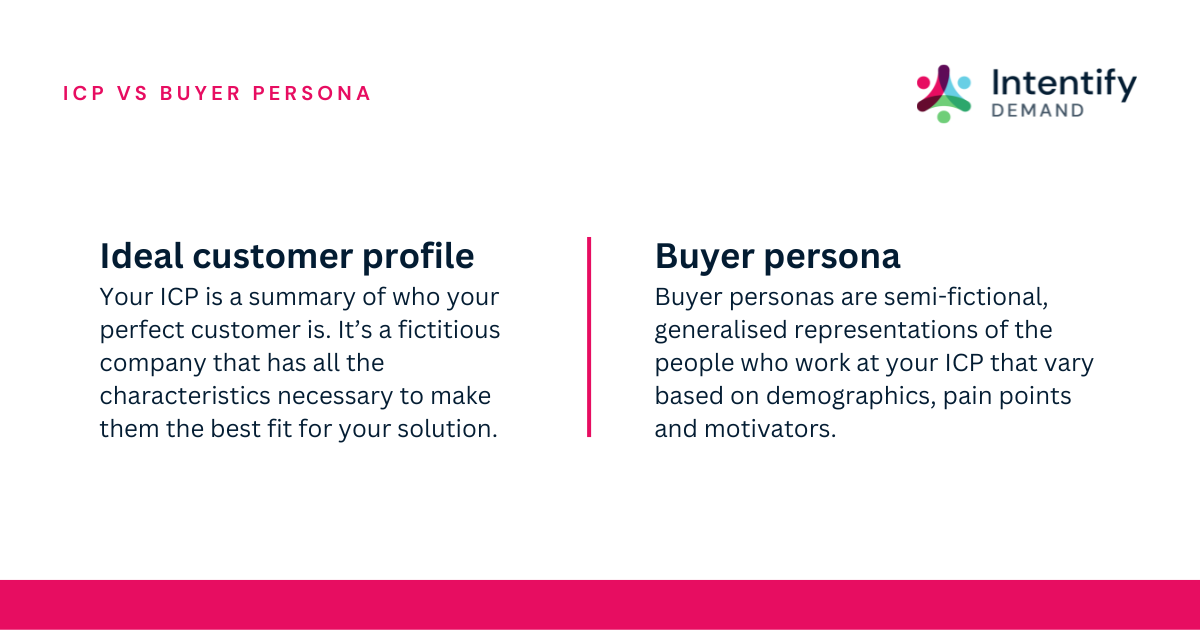Read time: 9 minutes
Research from Sales Insights Lab says that around 50% of leads aren't a good fit for the majority of B2B companies. And without the right marketing strategies in place, this can lead to wasted time, budget and resources, while making it significantly harder to find the right prospects.
But before you can even begin crafting the right strategy, or planning your marketing campaigns and follow-ups, you need to know exactly who your customer is.
Without a defined audience, lead generation often resembles target practice while wearing a blindfold. And if you continue to fill half of your contact database with bad fits, your sales team will continue to struggle with closing deals and winning business.
So what's the answer? It's time to build an ideal customer profile (ICP).
What is an ideal customer profile?
An ICP describes who your product or service is designed for. It's a summary of who your perfect customer is. By determining who your ICP is, you can identify common characteristics of the businesses most likely to buy from you which helps with identifying, evaluating and filtering potential leads.
This is particularly useful for account-based marketing (ABM) strategies where your tactics will focus on engaging only those who align closely with your ICP.
Ultimately, your ICP can include any criteria that you would use to filter prospects, but more often than now, they'll include:
- Industry - is your product or service only for specific business verticals? Or does it appeal to multiple verticals? Are there any verticals that you don't want to work with?
- Business size - what's the lowest threshold for a customer interested in your product or service? For example, enterprise-level solutions won't be suitable for small businesses and so company size will be important.
- Location - are there any geographical restrictions for your ideal customer?
- Revenue/budget - what's the minimum cost threshold for what you offer?
- Existing technology - does your product or service rely on your ICP already having specific tech in place? Or do they have a competitor solution in place?
Outlining these types of key characteristics and identifying what your ideal customer looks like means your sales team can spend time on the leads that are most relevant to you.
Need a helping hand? Download our ideal customer profile template
Why is an ideal customer profile important?
When done properly, a good ICP will enable you to better reach your target market by aligning your product or service with their needs while also giving cadence to your campaigns and direction to your marketing plan.
Without one, your marketing team will most likely feel like they're fumbling around in the dark and wondering why they aren't gaining traction with the right audience.
For B2B businesses looking to garner the trust of their target market, this is incredibly important. As being able to define who your ideal customer is gives a clear idea of who you're marketing to, which in turn provides clarity on how you can engage them.
What's the difference between an ideal customer profile and a buyer persona?
The two terms often get used interchangeably and while they are similar, they both have a slightly different purpose.
Your ICP focuses on the businesses that you want to target and engage with (which is why it's so crucial for ABM campaigns). Buyer personas, on the other hand, are fictionalised representations of the people you want to connect with.

Creating and using buyer personas should be done in tandem with your ICP (if you don't know who your ideal customer is, how can you target them?) but focus more on the people, their motivations and pain points. And can help with creating content for different seniorities within a decision-making unit (DMU) or for stakeholders within the business.
For example, if your product or service is designed for marketers, but often requires the involvement of tech teams for implementation, it would be important to have at least one buyer persona for each department.
Think of it like your email segmentation; however you segment your email lists whether that's by buying power, area of expertise or something else, it would be helpful to have a buyer persona to match.
It could be that your ICP is a company of any size (start-ups included) but they need to be in a specific industry. For small businesses, it's most likely that you'll be marketing directly to the MD or CEO, vs a senior manager or director in a larger business. So it would be worth creating a buyer person for these two types of buyers. Why? Because the everyday problems and pain points for a start-up CEO will be very different to a Head of Marketing in a larger business, and so your messaging and content will need to change as a result.
How to build an ideal customer profile
The impact of an ICP hinges on its accuracy. The profile isn't a wish list – instead, it should be a realistic reflection of the businesses that would benefit from your solution.
So how do you ensure your ideal customer profile is accurate and useful?
Identify who your best customers are
Who better to base your ICP on than businesses that have already demonstrated purchase intent? Start by looking at data from your existing customers.
When creating a shortlist of customers to profile, look for:
- Long-term customers
- Largest accounts, or your most profitable deals
- Customers that have seen measurable ROI from your offering
- Accounts that have renewed contracts or bought from you again
- Customers who have a good working relationship with your team
- Customers who have helped you shape product or service development
You should be able to find a lot of this information in your customer relationship management (CRM) platform, but it may take a bit of work and collaboration with the sales team to get a clear picture.
Make a note of what they have in common
Once you have your shortlist of customers, it's then time to look at which firmographic and technographic characteristics they share. Hopefully, you'll start to see a pattern emerge in terms of company size, industry or existing technology.
Recommended reading: 26 intent data terms you need to know for B2B marketing
You want to make a note of main attributes such as:
- Company size
- Annual revenue
- Industry
- Location
- Growth rate
- Technology
- Team size
Talk to your team (and your customers)
Supplement information about technology stacks and headcounts with context from your sales team. You want to dig deeper and uncover the core issues your current customers are experiencing. Understanding how these challenges, hurdles and pain points impacted the purchasing decision better positions you to understand who your ideal customer is.
Hold internal discussion groups, provide access to anonymous forms and collect customer feedback through surveys and focus panels. Whatever form you choose to use, make sure it's accessible and easy to use for everyone.
Consider the questions you want to ask your sales reps so you can better understand the customer journey:
- What questions did they ask during the first sales call?
- What hurdles did they have to overcome during the sales process?
- How large and complex is their DMU?
- How easily did your product or offering integrate with their existing tools?
- How smooth was the adoption?
And then think about how you can better understand the customer experience. Ask your most valuable customers:
- What problem(s) did your offering solve?
- How did they discover your business?
- What questions did they need to ask along the way?
Document your unique selling proposition (USP)
The final stage in creating your ICP is understanding what your USP is. It's important to outline and document what makes you different to help guide marketing messages and support sales teams.
In truth, this should have been done during product development, but as the market evolves, products and services often shift with it, so it's important to revisit what your USP is and regularly update it.
Your USP should also tie in nicely to the challenges and obstacles your customers told you about previously.
Time to pull it all together
Once you've been through all of the steps outlined above, it's time to tidy things up and finalise what your ICP looks like.
So what should your ICP look like?
- Create a list of firmographic information (industry, company size, geography etc.)
- Note down key pain points from your sales team and customer feedback
- Tie this back to your USP
Create a centralised document detailing all of the above that can be shared with the wider marketing team, as well as your sales reps. It's important that this information is easily accessible so it can be used to guide sales conversations and marketing activity.
Everyone from executives to business development representatives need to understand what it is and why you built it.
“Even in companies that have defined an ICP, its use is limited to marketing briefs or new hire orientations. By contrast, in high-growth companies, the ICP is integral to marketing and sales strategy and execution.” - Gartner
How to use your ideal customer profile to find sales prospects
And that's how you create an ICP.
But what now?
Once you're ICP has been finalised and agreed upon, it's time to put it to use.
So far, everything you've done has focused on previous customers but the true power of an ideal customer profile is leveraging it to find new potential customers.
Being able to understand who your ICP is, you can now look to expand on this using intent data.
It's no good going after every business that fits your ICP, as many may not yet be in-market for your solution or product. So combining your customer profile with intent data allows you to narrow down your target account list (TAL) to those who are actively searching for a solution.
Better yet, using predictive intent, you can start targeting the right accounts before they're actively in-market. This involves using specialist AI and machine learning models that already understand the purchase journey of your current customers to predict when your target accounts will be interested in what you have to offer based on similar behaviour patterns.
Leveraging your ICP in this way allows you to focus your marketing efforts on potential customers who are most likely to convert, meaning there'll be a higher return on investment (ROI) for your marketing activity.
This article was updated 13th March.




